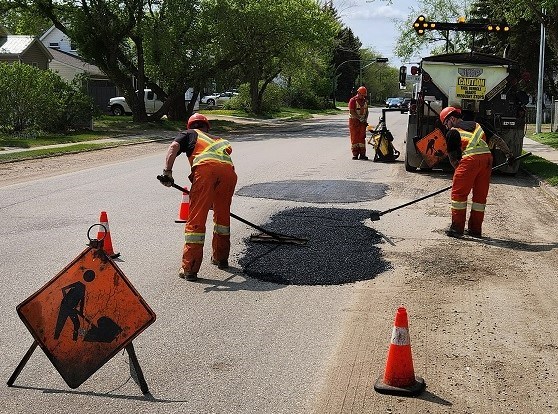Motorists may have had a smoother ride on more streets by the end of 2023 as city hall repaired the third-most potholes in the last three years and fixed fewer water main breaks.
By Dec. 31, 2023, the operations department’s public works and utilities sub-department had repaired 7,503 potholes. It also paved 123 utility cuts, repaired 15 pavement failures, repaired nine dips, fixed nine manhole covers and upgraded seven catch basins.
Furthermore, it painted 368 crosswalks, 361 top lines, 175 turning arrows and 27 railway crossing symbols. That painting included 46.2 kilometres of yellow lane lines and 53.6 kilometres of white lane lines.
Also, the department graded 42.8 kilometres of gravel roads and 90.9 kilometres of back lanes.
In comparison, the department filled 7,810 potholes by Dec. 31, 2022, and 7,718 potholes by Dec. 31, 2021; city hall did not have statistics for 2020.
Meanwhile, the department repaired 27 water main breaks in 2023, versus 55 in 2022, 55 in 2021 and 51 in 2020.
Also, the operations department paved 1.96 kilometres of roads and repaired 2,695 square metres of sidewalks, 18 pedestrian ramps, 115.25 metres of curbs and gutters and two catch basin replacements.
City administration presented a fourth-quarter report during a recent regular city council meeting. The document listed many activities that each department completed from Oct. 1 to Dec. 31, 2023.
Coun. Crystal Froese thought the number of potholes repaired last year was “impressive,” while water main breaks were also down significantly. She then inquired about how many breaks city hall had handled in January and February; the reply was 10, trending toward 16.
“That’s pretty impressive (as well). I guess we’re finally seeing a downward trend, maybe, instead of going up,” said Froese. “(There’s a) significant cost savings in that too.”
Other activities
Besides potholes and water main breaks, the fourth-quarter report listed other activities that the public works and utilities sub-department pursued from Oct. 1 to Dec. 31, 2023.
The sub-department received 877 calls for service, with garbage (341), streets and roads (247), recycling (94), water (82), and parking meters being the top issues. It resolved 843 complaints with a resolution rate of 96.1 per cent.
Staff repaired 70 parking meters and collected $133,799.04 in revenue. That money included $114,506.56 from coins and $19,292.48 from the HotSpot app.
The sub-department handled 1,076,460 cubic metres of potable water from the Buffalo Pound Water Treatment Plant, while it dealt with 1,004,675 cubic metres of wastewater.
Meanwhile, the landfill received 28,533.31 tonnes of refuse during the quarter, which included 25,304.44 tonnes of commercial garbage, 1,314.53 tonnes of private refuse and 1,914.34 tonnes of material from residential.
The report noted that the dump received 17,671.46 tonnes of sludge from the Buffalo Pound Water Treatment Plant, which accounted for the large increase in commercial business.
In comparison, in Q4 2022, the landfill received 13,174.07 tonnes of material.
With recycling, the sub-department received 62,119 kilograms of bulk material and 260,993 kilograms of curbside material, totalling 323,112 kilograms. However, the report said there was a 20-per-cent reduction in bulk recycling because of contamination, so the total material collected dropped to 310,688 kilograms.
In comparison, in Q4 2022, the city collected 328,468 kilograms of total recycling, but due to contamination in bulk, that number dropped to 316,444 kilograms.
In transit, there were an average of 886 trips per day in October, 953 average trips per day in November and 779 average trips in December. This resulted in 54,375 people using the system overall versus 41,348 people during the same period in Q4 2022 — a year-over-year jump of 31.5 per cent.
Meanwhile, there were 8,843 paratransit passengers in Q4 compared to 5,802 people in Q4 2022, an annual increase of 52.4 per cent.
The next regular council meeting is Monday, March 25.




